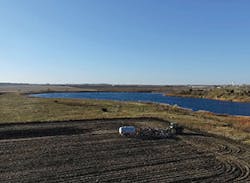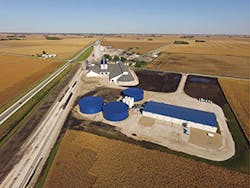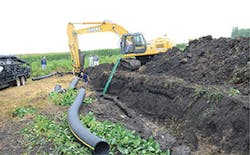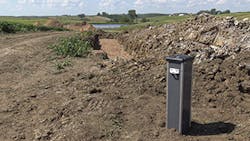While nitrogen is critical for agricultural production, too much nitrogen can negatively affect health and the environment. Ironically, excess nitrogen can even produce a harmful effect on crop yield, as well as native species and biodiversity.
A report from the Agricultural Sustainability Institute at the University of California, Davis, published by UC Press, indicates that excess nitrogen in the state comes primarily from agriculture and fuel combustion. The California Nitrogen Assessment reveals that about 1.8 million tons of nitrogen enters California each year. Agriculture represents the largest source of that and derives primarily from synthetic fertilizer, livestock feed, and nitrogen-fixing crops.
Harry Ahrenholtz, chairman of Agriculture’s Clean Water Alliance, would add tilling and manure to the list of causes that impact the natural process of mineralization of nitrogen in the soil.
The study estimates that, on average, vegetable and fruit crops use only half of the nitrogen applied to them. Excess nitrogen from crops leaks into the soil and groundwater. As much as 16% of California’s net nitrogen imports each year accumulate in groundwater, and 11% of nitrogen from cropland and livestock is lost as air pollution.
ADDING AND SUBTRACTING NITROGEN
Nitrogen can be applied via an irrigation system, says Stephen Smith, water resources and irrigation engineering, Wade Water LLC. “Irrigation technologies include pressurized irrigation, generally drip and sprinkler irrigation. But, any irrigation system, regardless of application efficiency, can be operated in such a way as to over-apply water and/or nitrogen fertilizer. Regardless of the irrigation method, if water is over-applied beyond crop water requirements and any necessary leaching fraction, then nitrogen becomes part of the return flow and is wasted.”
Smith says that because nitrogen fertilizer is expensive, no farmer is going to purposely over-apply it. But it’s not that simple.
Fields require balance, says Laura Christianson, assistant professor of water quality, Department of Crop Sciences at the University of Illinois. Harvesting crops removes nitrogen, “so you must replace nutrients in the spring. You can’t always take.”
Custom NH3 being applied on a farm in Hamilton County, Iowa, in the fall of 2015.
Corn is nitrogen-intensive. Forty or 50 years ago, says Ahrenholtz, farmers rotated crops: corn, meadow, and beans. Today, the trend is to plant corn and soybeans. That leads to more frequent applications of nitrogen, which, in turn, results in more leaching. During the seven months (October through April) when no crop is growing in corn-based rotations, nitrate in the soil is not taken up and can leach into drainage water.
Nitrogen leaches into groundwater as nitrate, which is a soluble ion that moves easily with water because it doesn’t bind to soil. Water-soluble chemicals are dissolved in water and go where the water goes. “Nitrates move freely with water,” emphasizes Ahrenholtz.
LEACH
Irrigation is common practice in California, where farmers and residents depend on groundwater because of ongoing drought and reduced snowpack. Unmonitored irrigation can lead to widespread leaching. After the California Nitrogen Assessment was released, the government began putting pressure on growers to monitor, control, and meter the water they used to irrigate crops, according to Bulut Ersavas, business development manager for Rain Bird ClimateMinder. “Leaching is a serious problem,” he notes.
Leaching pollutes both groundwater and air, contributing to climate change. Irrigation isn’t the only cause of leaching. The problem is highly geographically diverse. As Ahrenholtz points out, the average annual rainfall in Iowa is 34 inches, so farmers there use very little irrigation. Nevertheless, he says, they are “working hard to get a handle on nitrogen leaching issues.”
Christianson estimates that only 1 to 2% of Iowa’s cropland and 2 to 3% of Illinois’ is irrigated. In much of the Midwest, tile drainage is the problem. Tiles were put in during the 1900s to drain heavy Midwestern soils in order to enable planting on a massive scale. These soils are slow to drain naturally, requiring agricultural drainage to remove excess water from the soil and create a well-aerated environment for plant roots. Without drainage, crop production would not be possible on a large scale. However, this drainage results in an increase in nitrate loads in creeks, rivers, and the Gulf of Mexico, where it contributes to the low oxygen or hypoxic zone.
As stated in Ten Ways to Reduce Nitrogen Loads from Drained Cropland in the Midwest, published by L. E. Christianson, J. Frankenberger, C. Hay, M. J. Helmers, and G. Sands of the University of Illinois Extension, “drainage of wet agricultural soils allows timely field operations and helps plant growth to begin early and continue vigorously, resulting in improved productivity.”
Standing water can be removed by surface drainage—shallow ditches and other methods—and subsurface water can be removed through underground pipes, known as tiles because historically, they were made of clay tile. Installed just below the root zone, drainage tiles run to an open ditch or stream, where water is discharged.
Iowa, Illinois, Ohio, and Indiana each have more than 5 million acres with subsurface drains, and new drainage systems are being installed in states where subsurface drainage was historically less common, including North and South Dakota, northwestern Minnesota, and Missouri. Studies have shown that subsurface drainage systems increase the movement of nitrate from fields to surface waters.
A new facility upgrade
“Nitrogen leaching issues are prevalent in the Midwest, but there’s concern in other areas even without tile drainage,” acknowledges Christianson. “Nitrogen can leach in sandy soil too. There are different answers for different areas, but our focus is tile drainage.”
The challenge with leaching, Christianson continues, is that the soil in the Midwest is formed from prairie. “It has a lot of nitrogen, so the soil itself contributes to leaching as well as tile drainage.”
TROUBLE FLOWING LIKE WATER
Rainfall is one of the most important factors in how much nitrogen leaves the fields, Christianson declares, noting that much of the Midwest experienced a wet 2016, resulting in more drainage water leaving the fields.
Precipitation and management practices impact annual average drainage water nitrate concentrations, according to Ten Ways to Reduce Nitrogen Loads from Drained Cropland in the Midwest, but the numbers often exceed 10 mg nitrate-nitrogen per liter, the US Environmental Protection Agency’s (EPA’s) standard maximum limit for drinking water. Some areas in California regularly fail to meet federal drinking water standards for nitrates.
They aren’t the only ones. “The EPA requires at or below 10 ppm [parts per million] nitrate for drinking water,” reiterates Ahrenholtz. Due to heavy amounts of rain, the levels in the Raccoon and Des Moines rivers in Iowa spiked, leading the Des Moines Water Works to file suit against three counties.
To fix the problem, Ahrenholtz says they have adopted a nitrate removal system. The City of Des Moines now operates one of the world’s most expensive nitrate-removal facilities to treat local drinking water.
In addition, he says Iowa adopted a nutrient reduction strategy intended to lower nitrogen and phosphorous by 45%. Across the Mississippi River Basin, 45% reductions in nitrogen and phosphorus loads are necessary to meet national goals established to decrease the size of the hypoxic zone in the Gulf of Mexico. Several methods are being used, all of which have different nitrogen-reduction effectiveness, spatial suitability, additional benefits, impacts, and cost.
SOLUTIONS
Research is focusing on ways that cropping systems and drainage systems can be managed to reduce nitrate loads, while maintaining high agricultural productivity. For now, Ten Ways to Reduce Nitrogen Loads from Drained Cropland in the Midwest presents two basic methods for reducing nitrate in drainage outflow: reduce the concentration of nitrate in the drainage water and reduce the amount of drain flow that arrives at the outlet. Both can be achieved through biological, chemical, or physical processes.
A saturated buffer uses a control structure to divert drainage water through a perforated drain pipe that extends laterally along a riparian buffer. Water flows through the soil in the buffer, where it has a chance to interact with plants and microbes in the buffer for nitrate removal. Saturated buffers reduce nitrate loads by 50% on average.
“Tillage is important,” asserts Ahrenholtz, pointing to the “no till” movement and the more recent “strip till” method of tilling only a narrow row in the spring. Leaving the previous year’s crop remnant helps absorb and slow the movement of water, he explains. “It helps with run-off. We’ve made a lot of progress.”
No-till or reduced tillage reduces the amount of phosphorous and sediment lost, Christianson adds. “It doesn’t change how much nitrogen goes through the tile, though.”
One way to do so is to plant winter cover crops. “Keep something growing on the land as many months as possible,” advises Ahrenholtz. “It reduces erosion and traps nitrates if you cover the soil.”
Indeed, Ten Ways to Reduce Nitrogen Loads from Drained Cropland in the Midwest submits that the “fact that there is little or no living vegetation on the soil for seven or more months of the year in conventional Midwestern cropping systems is a significant alteration from pre-agricultural conditions.”
Drainage water quality is not always the primary reason for planting cover crops. Many farmers use them to improve soil physical properties and reduce compaction, increase soil organic carbon, recycle nutrients, and improve weed control. Cover crops are also very effective at reducing soil erosion caused by both wind and water.
There are many benefits to planting cover crops. Winter cover crops and perennial crops increase nitrogen uptake in the traditional non-growing season.
A bioreactor is a trench filled with wood chips that drainage water is routed through. Denitrifying bacteria in the wood chips convert nitrate in the drainage water into nitrogen gas, reducing the amount of nitrate delivered to the outlet. On average, bioreactors reduce nitrate loads by 43%.
Perennials are plants that can grow for two or more years without re-planting. Midwestern agricultural landscapes before the 1960s typically included perennial crops like alfalfa that were used for livestock feed. Some of the more common perennial crops today include:
- Forages (grasses and legumes) planted for hay, grazing, or pasture
- Trees and woody species grown for nut, fruit, or wood production (apples, grapes, hazelnuts, poplars, and walnuts)
- Perennial biomass crops (trees, shrubs, and grasses including poplar, willow shrubs, and switchgrass)
- Perennial grains and oil seed crops (Illinois bundleflower, wheat, sunflower, and flax)
“California grows a wide variety of crops like citrus and grapes in the Central Valley. Those are permanent crops,” points out Ersavas. “And veggies and berries along the Central Coast, which are rotated and irrigated with pumped ground water.”
It should be noted that annual row crops such as corn and soybeans typically have much higher nitrate losses than perennial crops. Nitrate losses are lowest for perennial grass crops, particularly for multiple years of alfalfa or grass sod crops, because they absorb nitrogen whenever oil mineralization occurs.
Another method of reducing the amount of nitrogen entering our waterways is with saturated buffers. “Interrupt the tile line,” says Ahrenholtz. Using parallel tiles to send part of the water to a drainage creek instead of delivering it directly to surface runoff allows it to seep through soil along the creek bed.
Saturated buffers, or Riparian buffers, are zones of vegetation along stream banks or ditches, designed to improve water quality by slowing surface runoff from cropped fields. Buffers allow water to infiltrate, which helps filter sediment in the runoff and traps nutrients for later uptake by plants.
Edge-of-field and offsite vegetation can be used in saturated buffers and open ditches. As explained in the University of Illinois article, open-ditch systems are links between in-field drainage systems and downstream lakes and rivers. Open ditches are typically natural streams that have been artificially deepened and straightened or new channels constructed to serve as an outlet for field drainage systems. The benefits they offer include improved and more efficient nitrogen retention within the open-ditch plants and soil, reduced flood peaks and increased flow during low-flow periods, improved biological diversity and integrity of ecosystems, and decreased maintenance cost associated with reduced frequency of maintenance.
Reducing the amount of drainage flow curbs nitrate loss and improves water quality. Many experts recommend drainage water management, wider drain spacing, shallow drains, recycling drainage water, and other practices that allow plants to uptake increased amounts of water.
Drainage water management, or controlled drainage, consists of the use of adjustable, flow-retarding structures placed in the drainage system that allow the outlet level (or water depth) to be adjusted, according to Ten Ways to Reduce Nitrogen Loads from Drained Cropland in the Midwest. Wider or more shallow drainage helps hold more drainable water in the soil and slows movement to waterways because the water table must rise above the outlet level before drainage will occur. Drainage water management provides an average net decrease in nitrate loads of approximately 30% in the Midwest.
Wetlands can also help decrease the nitrate concentration in drainage bound for streams and rivers. Wetlands are dynamic ecosystems containing plants, soil, bacteria, and water. Constructed or reconstructed wetlands can benefit water quality by removal of nitrate through denitrification and other processes. Wetlands, saturated buffers, open-ditch design, and bioreactors provide good environments for denitrifying microbes.
Bioreactors are trenches filled with a carbon source, such as wood chips, through which drainage water is routed. It treats water and reduces nitrate concentrations by augmenting the natural, biological process of denitrification.
Denitrification bioreactors reduce nitrate in drainage water by significantly enhancing the process of denitrification as the water passes through the carbon source. By providing native denitrifying bacteria, bacteria can be encouraged to denitrify at greater rates than in the surrounding soil. Denitrification bioreactors in the field have been reported to remove from 12 to 98% of annual nitrate loads, with an approximate average of 30 to 40%.
Bioreactors are part of the nutrient-reduction strategy, Ahrenholtz says, that is being used in Iowa. After choosing a selected area, they interrupt the tile line, sending water through the bioreactor. “It’s very effective to reduce nitrates.”
One of the most effective ways of reducing nitrogen in irrigated fields, Christianson believes, is to recycle drainage water. Instead of sending water downstream, it is stored in a pond or reservoir. “Later in the season, you can use it for irrigation,” she explains.
Recycling the drainage water can reduce nitrate loss by reducing or eliminating the water that leaves the site. Nitrate in the soil is more completely used in the production of crops. According to Ten Ways to Reduce Nitrogen Loads from Drained Cropland in the Midwest, “There should be minimal nitrate remaining in the soil profile at the end of the growing season, thus less leaching of nitrate during the non-growing season.”
While recycling has supplemental benefits, Christianson says not many are doing it because of the cost. Onsite storage of drainage water requires construction of a pond or reservoir, which takes some land out of production, and may require pumping facilities to move the drainage water to the reservoir and back to the soil. “The problem in the Midwest is that we have too much water, but with climate fluctuations, there will be more drought.” Thus, recycling may become a more attractive method of irrigation.
Rain Bird ClimateMinder Weather and Flow Monitoring Station in a Vineyard in Shandon, CA.
SCHEDULING
A recycling program may lead to a need to adjust fertilizer rates. “Although some nitrogen will evaporate, there will be some ‘cycling’ of nitrogen in the pond, so the initial amount should be reduced,” elaborates Christianson. The real benefit of recycling, she emphasizes, is supplemental irrigation.
To determine just how much nitrogen is needed, she advises soil sampling and following the university nitrogen management guidelines—an online calculator that provides the recommended rate of application, based on crop rotation.
Ahrenholtz also suggests the MAPPS program—grid sampling. New in the last 10 years, it provides recommendations for site-specific application rates using GPS, per a grid of approximately 2 1/2 acres.
Nitrogen fertilizer helps California produce 21% of the nation’s dairy commodities and more than half of the nation’s fruits and vegetables. Numbers in the Midwest are similar. However, over-application of fertilizer wastes money and leads to leaching. “Leaching wastes fertilizer and contaminates groundwater,” confirms Christianson.
Once you know how much fertilizer and water is needed, you have to determine when they are needed. “It is a complex question because of the intertwined issues of nitrogen application approach, application rate, plant uptake rate, and, very important, irrigation efficiency,” muses Smith.
Irrigation scheduling is a “very, very important technology” that saves water and fertilizers, continues Smith. “Basically, irrigation scheduling is understanding the crop water requirements so that water can be applied based on the crop water needs and the crop growth stage.”
He recommends weather stations, either on the farm or part of a weather station network, are best for monitoring the crop evapotranspiration rate over the season. “By utilizing a suitable crop coefficient, water applications can be scheduled to match but not exceed crop water requirements.”
Fertilizer is much the same, Ahrenholtz contends. “Time of application affects leaching.” He believes that irrigation folks have an advantage because they can “spoon-feed” fertilizer when they irrigate. “You can fall-apply nitrogen, but a lot of growers are going to spring-apply or split application.” Studies show that spring applications can be better because they allow the plant added time to take up more nitrogen than fall applications are able to.
MONITORING
“The tricky part is how much and when to apply fertilizer,” acknowledges Ersavas. “People used to base the decision on intuition and experience. Now people rely on measuring and looking below the ground, but more education is needed.”
Applying nitrogen at the right time, the right rate, and the right place will reduce leaching. To determine the correct rate and appropriate location(s), monitoring crop nitrogen status is critical. Rain Bird ClimateMinder produces agricultural monitoring and control systems.
Of the different types of sensors, Ersavas refers primarily to a soil moisture sensor for the root zone that integrates with flow meters to see how much water is applied and to follow the movement of fertilizer with the water, and an EC sensor to monitor electrical conductivity. Both provide and analyze data with the goal of keeping nitrogen in the root zone, where it can be used by crops.
ClimateMinder’s sensor is a wireless station attached to a metal post in representative spots in a zone, where it collects data (there are approximately 30 to 40 acres per zone). It provides data every 15 minutes, allowing the grower to monitor via cell phone and receive reports via email. It can be controlled remotely and automatically. “Just log in to the website,” says Ersavas. “You can turn it on or off, or schedule irrigation. It is precise and simple.”
While the sensor considers geographic contours, matches water needs, and micro-manages variations, it only measures nitrogen indirectly. A system that does is being developed, Ersavas says, but there is currently no low-cost, real-time monitor available for large-scale applications.
It’s just one of the directions he believes the future is taking monitoring. “We’ll see integration with other platforms—imagery through drones and satellites,” continues Ersavas. He envisions monitoring energy usage by keeping an eye on how much pumping is done and how much electricity is used.
The big problem now is getting more attention to the issue of nitrogen leaching, Ahrenholtz believes. While no single practice will be the best option in every situation or location, it’s important to reduce drainage nitrate loads from conventionally drained row crop-based systems everywhere, one way or another, with cutting-edge technology or old-fashioned biological means.





